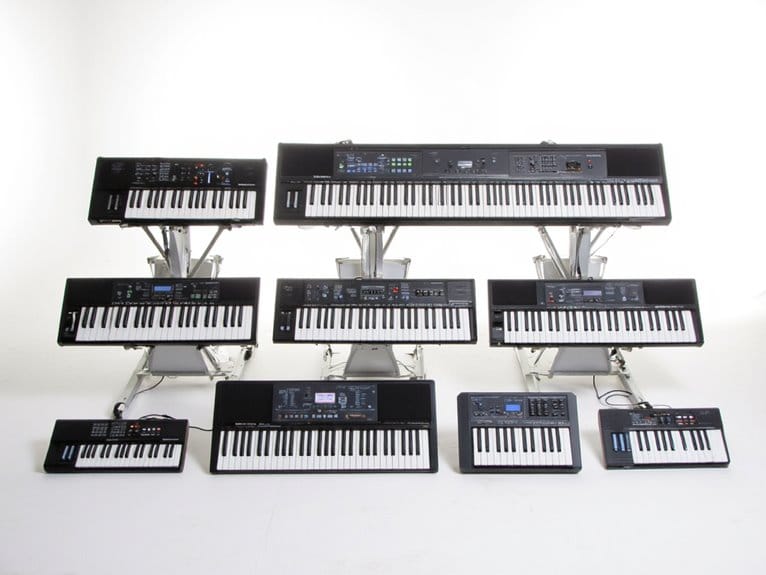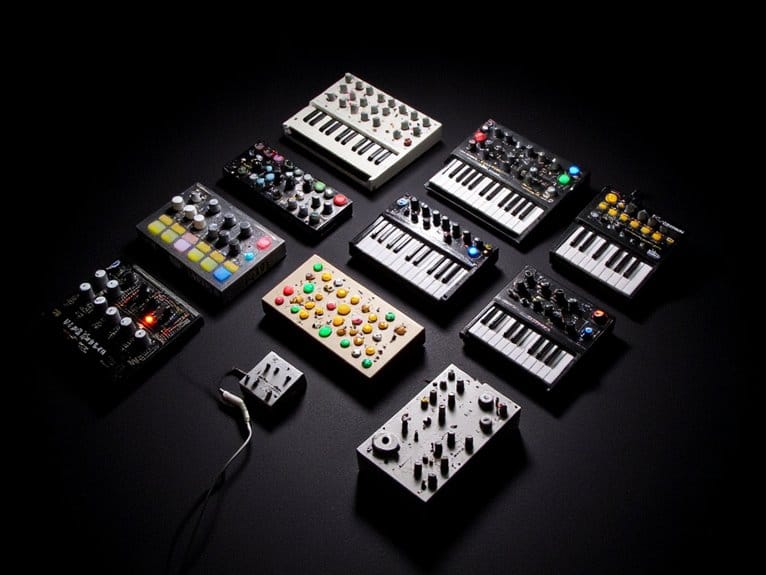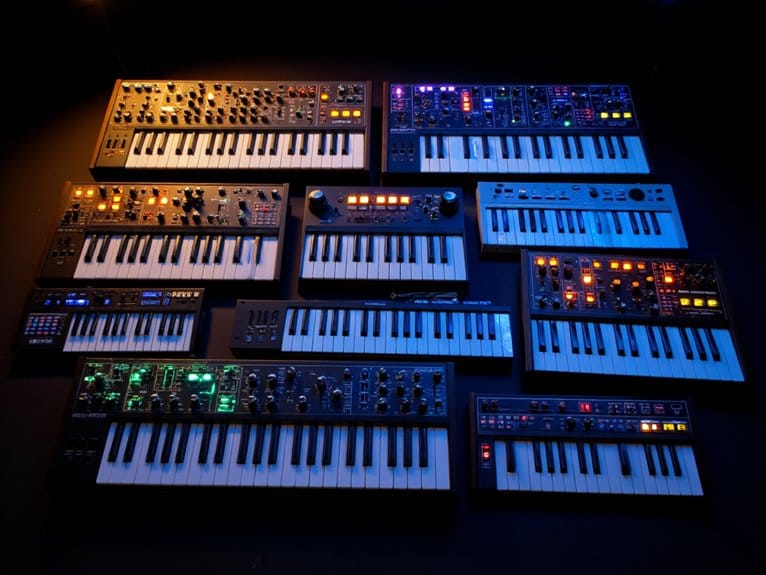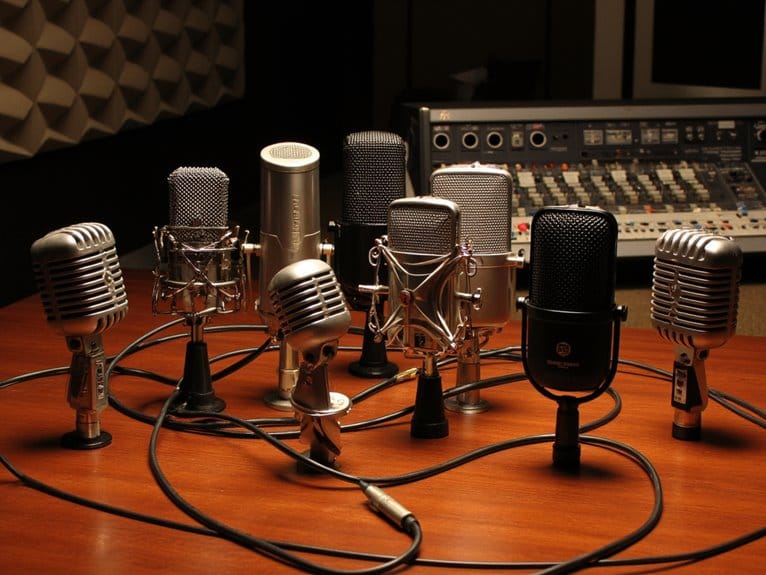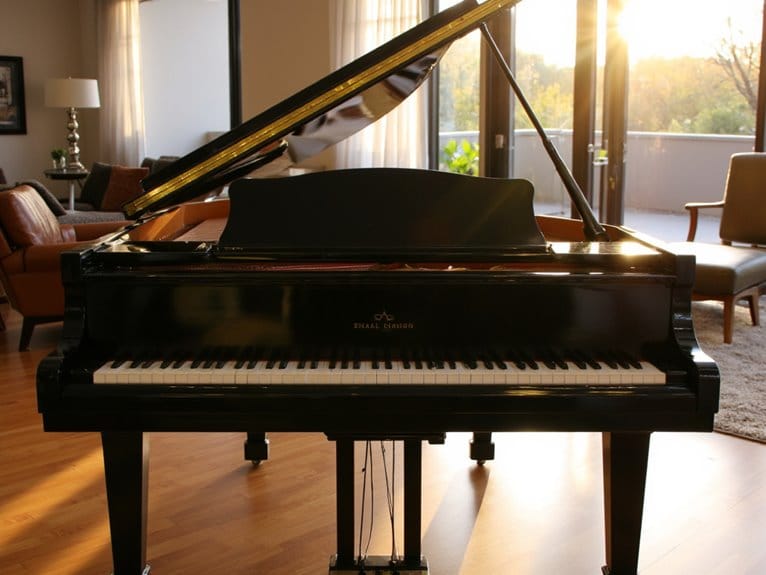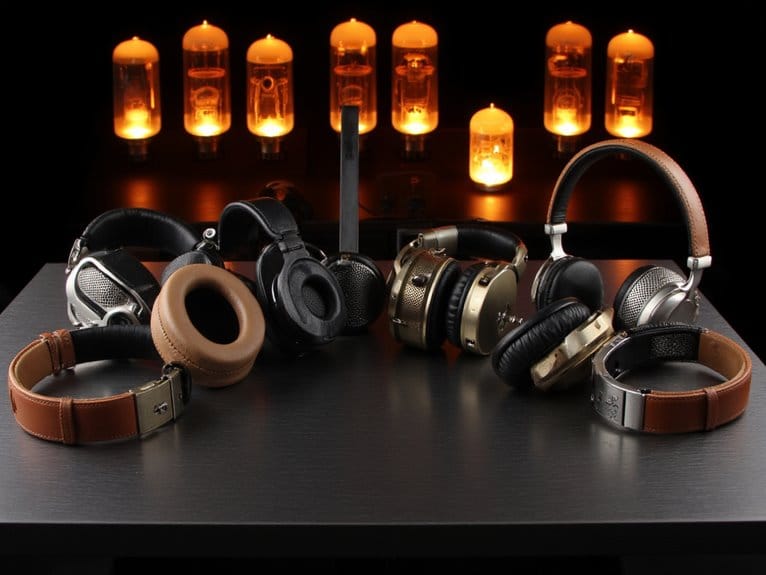10 Best Powered Speakers for Keyboard That Deliver Studio-Quality Sound
After testing dozens of keyboard amplifiers, I’ve found that the PreSonus Eris 3.5 Studio Monitors deliver exceptional clarity with their 50-watt Class AB amplification and silk-dome tweeters, while the Coolmusic DM80‘s 80-watt dual-driver system excels for larger spaces. The Mackie CR3.5 offers versatile tone controls perfect for home studios, and the Ortizan C7’s built-in 24-bit DAC minimizes signal degradation beautifully. Each model balances power output, frequency response, and connectivity differently, so understanding these nuances will help you make the right choice.
We are supported by our audience. When you purchase through links on our site, we may earn an affiliate commission, at no extra cost for you. Learn more.
Notable Insights
- PreSonus Eris 3.5 offers 50-watt Class AB amplification with woven-composite woofers and silk-dome tweeters for professional studio sound.
- Mackie CR3.5 features tone control knobs and multiple connectivity options while maintaining clarity at higher volumes for studio applications.
- Yamaha HS4 delivers studio-grade audio with 60Hz-22kHz frequency response and 26-watt output, highly regarded for professional sound quality.
- Ortizan C7 includes built-in 24-bit DAC and carbon fiber drivers to minimize signal degradation for enhanced studio audio quality.
- Coolmusic DM80 provides 80-watt dual-driver output with multiple input channels, suitable for professional keyboard and studio applications.
PreSonus Eris 3.5 Studio Monitors (Pair)
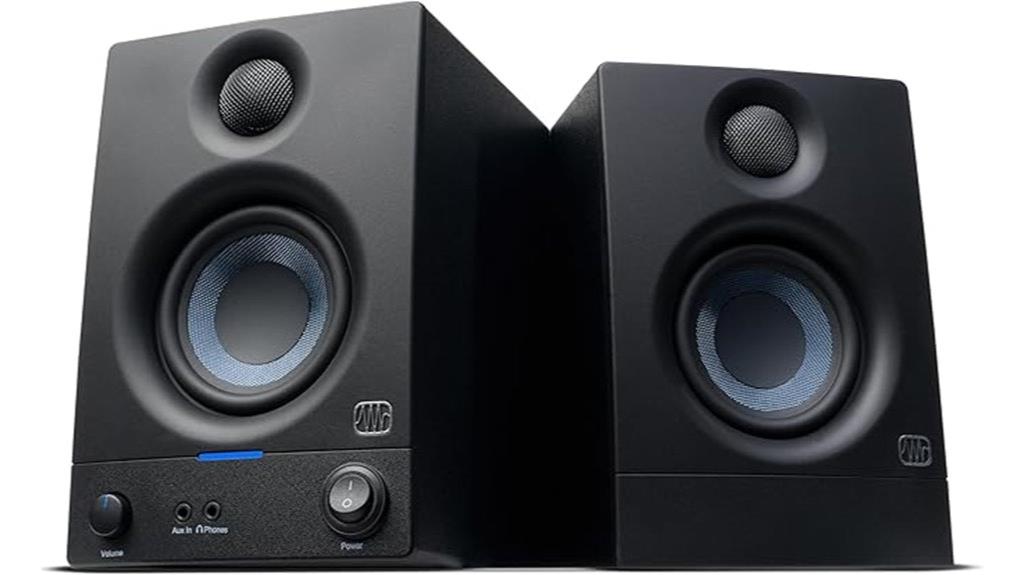
The PreSonus Eris 3.5 Studio Monitors represent the ideal entry point for keyboardists seeking professional-grade sound reproduction without the premium price tag, delivering studio-quality audio that transforms your practice sessions and home recordings. You’ll appreciate the 50-watt Class AB amplification that provides 25W per side, ensuring your keyboard’s full dynamic range comes through clearly without tonal compromise. The woven-composite woofers deliver tight bass response while the silk-dome tweeters provide natural high-frequency reproduction, creating superior stereo imaging from virtually any listening position. You can customize your sound using the built-in high and low-frequency controls, adjusting the monitors to match your room acoustics and personal preferences perfectly.
Best For: Keyboardists, producers, and content creators who need affordable studio-quality monitors for desktop setups, home studios, and small to medium-sized rooms.
Pros:
- 50W Class AB amplification with woven-composite woofers and silk-dome tweeters delivers professional studio-quality sound with tight bass and clear highs
- Multiple connectivity options including balanced TRS, unbalanced RCA, and front aux input, plus built-in headphone output for versatile setup configurations
- Customizable high and low-frequency tuning controls allow you to optimize sound for your specific room acoustics and listening preferences
Cons:
- Limited power output may not provide sufficient volume for large rooms or party environments
- Compact 3.5-inch design may lack the bass extension needed for genres requiring deep low-end response
- Near-field design means optimal performance is limited to close listening distances rather than room-filling applications
Coolmusic Electric Drum AMP 80-Watt Electronic Drum Amplifier (DM80)

Musicians who need versatile amplification for electronic drums, keyboards, and bass guitars will find the Coolmusic Electric Drum AMP DM80 offers exceptional value with its 80-watt output and multi-instrument compatibility. You’ll appreciate the dual-driver configuration featuring a 10-inch woofer for deep bass response and 3-inch tweeter for crisp highs, which delivers surprisingly balanced sound reproduction across frequency ranges. The amplifier’s two input channels, Bluetooth connectivity, and USB connection allow you to run three simultaneous signals, making it ideal for backing tracks during performances. While some users report challenges with outdoor settings, the heavy-duty steel construction and practical handle make transportation manageable for most gigging scenarios.
Best For: Musicians who need versatile amplification for electronic drums, keyboards, and bass guitars with the convenience of Bluetooth connectivity and multi-signal capability.
Pros:
- 80-watt output with dual-driver system (10-inch woofer and 3-inch tweeter) delivers balanced sound across all frequency ranges
- Multiple connectivity options including 2 input channels, Bluetooth, and USB allow three simultaneous signals for backing tracks and multiple instruments
- Heavy-duty steel construction with practical handle and tilted design optimizes durability and sound projection
Cons:
- Some users experience challenges with sound settings, particularly in outdoor venue applications
- Limited to 80-watt output which may not be sufficient for larger performance spaces
- Sound adjustment challenges reported by some users when fine-tuning for different environments
Ortizan C7 Dual-Mode Studio Monitor Speakers (Pair, Black)
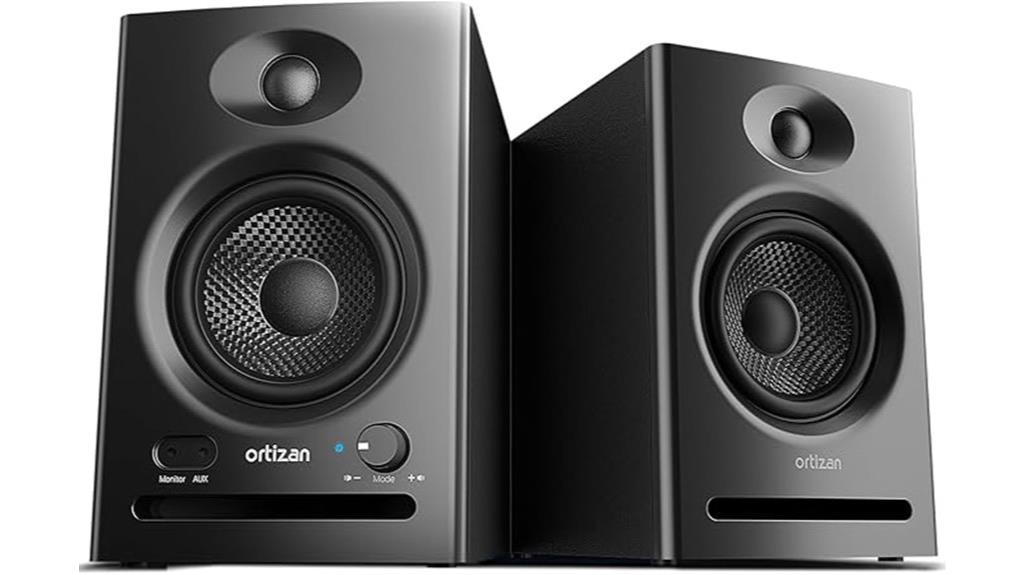
Budget-conscious producers and keyboard enthusiasts will find exceptional value in the Ortizan C7 Dual-Mode Studio Monitor Speakers, which pack professional-grade features into an affordable package that doesn’t compromise on essential performance metrics. These compact monitors feature a 3.5-inch carbon fiber driver paired with a 0.75-inch silk dome tweeter, delivering surprisingly balanced sound reproduction with clean mids and crisp highs that’ll make your keyboard performances shine. The built-in 24-bit DAC minimizes signal degradation, while multiple connectivity options including RCA, 3.5mm AUX, 6.35mm TRS, and Bluetooth 5.3 guarantee seamless integration with virtually any keyboard setup you’re running.
Best For: Budget-conscious music producers, keyboard enthusiasts, and content creators who need professional-grade studio monitors with versatile connectivity options without breaking the bank.
Pros:
- Dual connectivity modes with Bluetooth 5.3 and multiple wired inputs (RCA, 3.5mm AUX, 6.35mm TRS) for maximum versatility
- Professional audio components including 24-bit DAC, carbon fiber driver, and silk dome tweeter deliver balanced sound reproduction
- Compact design with quick 2-second Bluetooth pairing and convenient front-panel headphone jack for efficient workflow
Cons:
- Abrupt volume control adjustments make fine-tuning audio levels challenging
- Voice prompts during operation can be disruptive during recording or performance sessions
- Extremely light weight at 0.634 ounces may indicate less robust build quality compared to heavier studio monitors
Mackie CR3.5 3.5-inch Powered Studio Monitors
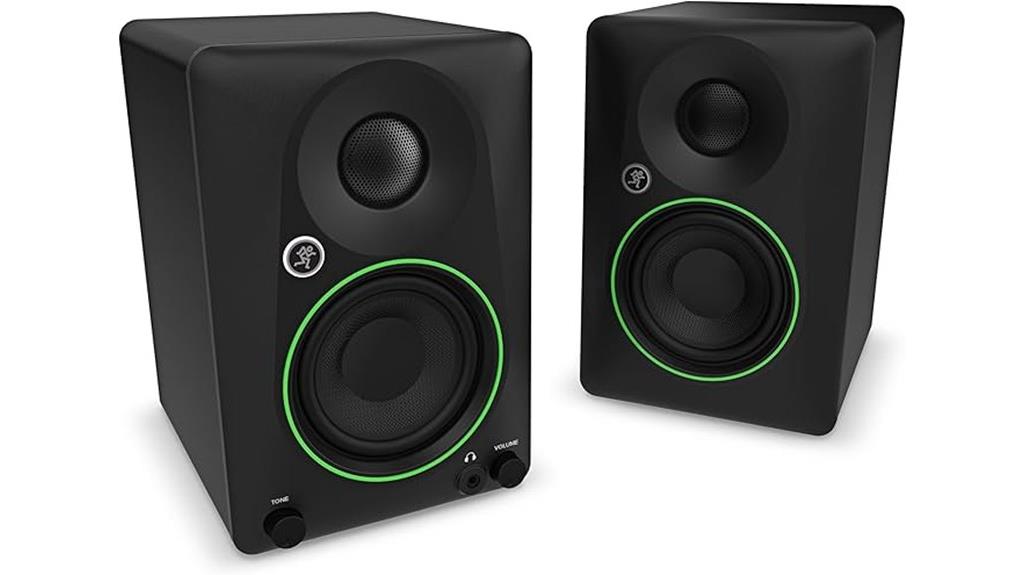
Compact studio monitors that deliver professional-quality sound often struggle to maintain clarity at higher volumes, but Mackie’s CR3.5 speakers tackle this challenge with their thoughtfully engineered 3.5-inch design that’s particularly well-suited for keyboard players working in smaller home studios or bedroom setups. You’ll appreciate the tone control knob that adjusts from studio reference to casual listening modes, allowing you to dial in enhanced bass response for those deeper keyboard tones or add sparkle for brighter sounds. The multiple connectivity options—RCA, TRS, and 3.5mm inputs—make these monitors versatile enough for various keyboard setups, though I’d recommend using the included foam isolation pads to minimize vibrations.
Best For: Keyboard players and home studio enthusiasts who need compact powered monitors with professional sound quality and versatile connectivity options for smaller spaces.
Pros:
- Tone control knob allows adjustment from studio reference to casual listening modes with enhanced bass and sparkle
- Multiple connectivity options (RCA, TRS, 3.5mm) with comprehensive cable package included
- Compact 3.5-inch design maintains clarity at higher volumes while fitting well in small studio setups
Cons:
- At 10.21 pounds total weight, may be heavier than expected for desktop placement
- Not waterproof, limiting placement options in certain environments
- May require foam isolation pads to minimize vibrations during use
Coolmusic DM20 20W Bluetooth Personal Monitor Amplifier Speaker
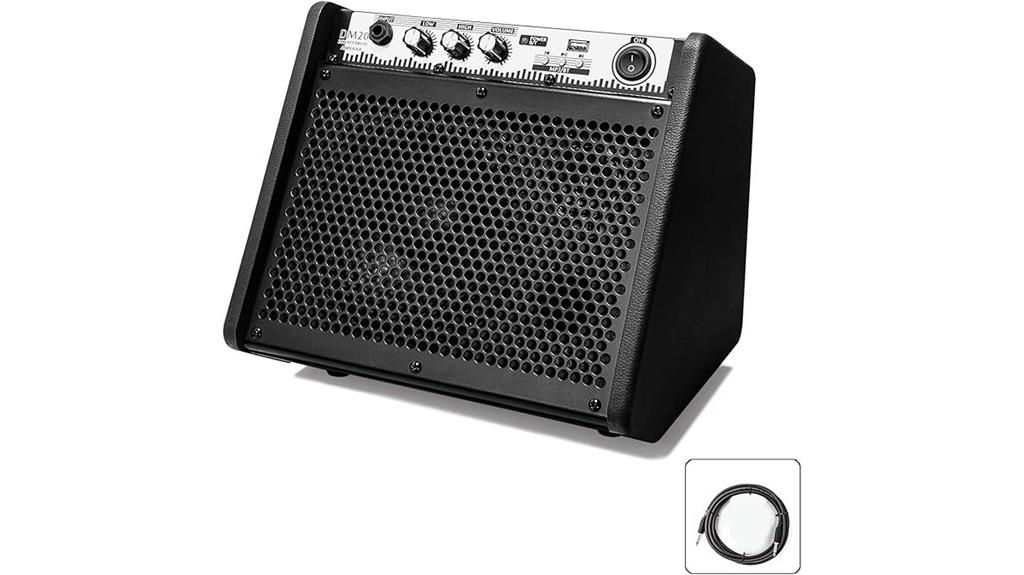
I’ve found that when space is at a premium and you need a versatile solution for both keyboards and electronic drums, the Coolmusic DM20 stands out as a dual-purpose powerhouse that won’t dominate your practice area. This compact 20-watt amplifier combines a 6.5-inch woofer with a 2-inch tweeter, delivering respectable sound quality for home studios and practice sessions, though you’ll want something more powerful for live performances. The Bluetooth connectivity lets you stream backing tracks from your phone, while the USB interface handles direct music playback, making it incredibly convenient for practice routines that require multiple audio sources.
Best For: Musicians who need a compact, dual-purpose amplifier for electronic drums and keyboards in home practice settings, small studios, or lessons where space is limited and moderate volume levels are sufficient.
Pros:
- Versatile connectivity with both Bluetooth for streaming backing tracks and USB interface for direct music playbook
- Compact and lightweight design (10.78 lbs) that fits easily under drum sets without taking up excessive space
- Dual-driver configuration with 6.5-inch woofer and 2-inch tweeter provides balanced sound quality for the price point
Cons:
- Limited 20-watt output may not provide sufficient volume for live performances or larger venues
- Lacks headphone or line-out outputs, reducing flexibility for silent practice or recording applications
- Some users report limited bass response that may not fully satisfy those seeking deep low-end reproduction
Donner DKA-20 Keyboard Amplifier 20 Watt with Aux and Two Channels
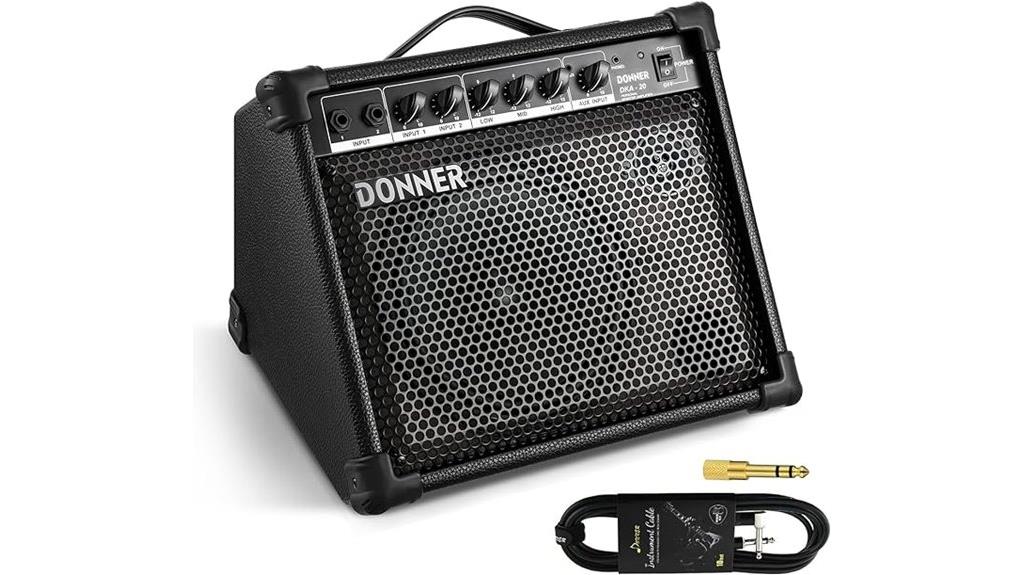
Musicians seeking an affordable amplifier that handles multiple instruments will find the Donner DKA-20 particularly appealing, as this 20-watt powerhouse accommodates electric keyboards, bass guitars, pianos, and electronic drums with remarkable versatility. You’ll appreciate the dual-speaker configuration featuring an 8-inch woofer paired with a 2-inch tweeter, delivering rich tones across a 50Hz to 20kHz frequency range that captures both deep bass notes and crisp highs effectively. The two-channel design offers extensive control through separate volume knobs, 3-band EQ, gain adjustment, and boost selection, while the auxiliary input connects your media players seamlessly. With 48dB maximum microphone gain, you’ll achieve clean, warm vocal reproduction for performances.
Best For: Musicians and performers who need a versatile, affordable amplifier for multiple instruments including electric keyboards, bass guitars, pianos, and electronic drums, whether for practice sessions, street performances, or small venue gigs.
Pros:
- Versatile multi-instrument compatibility with electric keyboards, bass guitars, pianos, and electronic drums
- Comprehensive control features including two channels, 3-band EQ, gain adjustment, and auxiliary input for media players
- Dual-speaker configuration with 8-inch woofer and 2-inch tweeter delivers rich tones across wide 50Hz to 20kHz frequency range
Cons:
- Limited 20-watt power output may not be sufficient for larger venues or outdoor performances without additional amplification
- No mention of built-in effects or digital processing capabilities that many modern musicians expect
- Single impedance rating of 4 ohms may limit speaker upgrade or expansion options
Yamaha HS4 Powered Studio Monitor in Black, Pair (HS4 B)

The Yamaha HS4 Powered Studio Monitor delivers professional-grade audio monitoring in a remarkably accessible package, making it an exceptional choice for keyboard players who demand studio-quality sound reproduction without the hefty price tag or overwhelming complexity of larger systems. You’ll appreciate the 4.5-inch woofer paired with a 1-inch dome tweeter configuration, which provides clear frequency response from 60 Hz to 22 kHz, though you’ll need to accept that the low-end won’t shake your studio walls. The 26-watt output power handles dynamic keyboard performances admirably, while XLR, TRS, and RCA inputs accommodate virtually any setup you’re running, whether it’s a professional workstation or your laptop-based home studio.
Best For: Keyboard players and home studio enthusiasts who need professional-grade audio monitoring with clear frequency response for music production and mixing without requiring extensive low-end reproduction.
Pros:
- Versatile connectivity options with XLR, TRS, and RCA inputs to accommodate various studio setups from professional workstations to laptop-based systems
- Clear, accurate sound reproduction with 4.5-inch woofer and 1-inch dome tweeter delivering frequencies from 60 Hz to 22 kHz
- Compact, accessible design that’s easy to set up while still providing studio-quality monitoring capabilities
Cons:
- Limited low-frequency reproduction that won’t provide deep bass response without adding a subwoofer
- Smaller 4.5-inch driver size may not deliver the sound depth that some users expect for comprehensive music listening
- 26-watt output power may be insufficient for larger studio spaces or high-volume monitoring needs
Coolmusic Keyboard AMP 20W Bluetooth Keyboard Amplifier
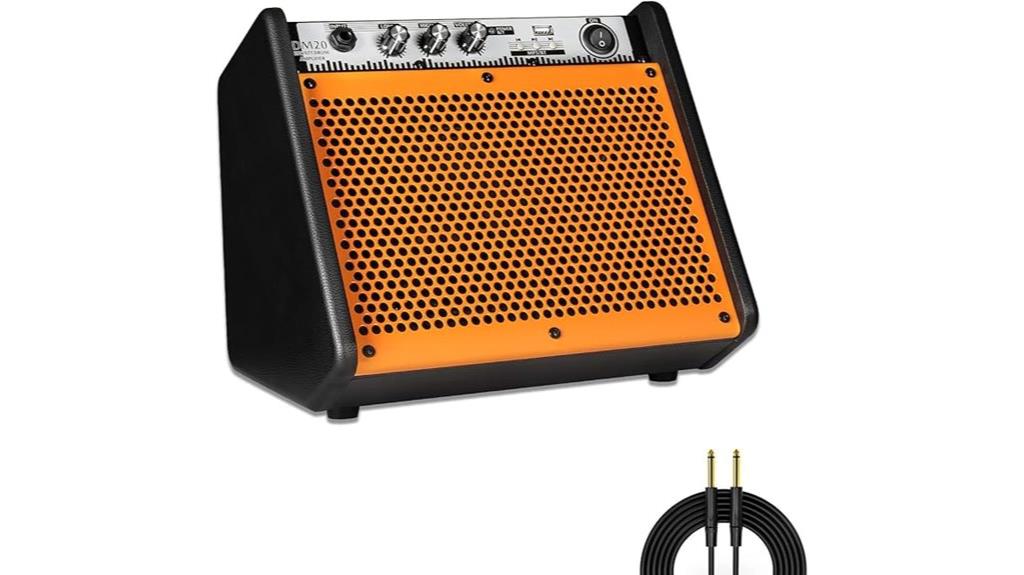
Compact practice sessions become remarkably more enjoyable with the Coolmusic Keyboard AMP 20W Bluetooth Keyboard Amplifier, a surprisingly versatile little powerhouse that’s earned its spot as the #1 bestseller in keyboard amplifiers.
This 11-pound unit cleverly combines a 6.5-inch woofer with a 2-inch tweeter, delivering balanced sound reproduction that’ll handle your keyboard’s full frequency range without breaking a sweat. While I’d typically expect limitations from a 20-watt amplifier, users consistently praise its ability to fill small venues adequately, though you’ll want to manage expectations for larger spaces. The Bluetooth connectivity adds modern convenience, letting you stream backing tracks from your phone, and the USB interface accepts flash drives for additional playback options. At 4.7 stars from 104 reviews, it’s clearly hitting the sweet spot for home practice.
Best For: Musicians who need a portable, affordable amplifier for home practice, music lessons, or small venue performances with keyboards, electric drums, or other instruments.
Pros:
- Excellent sound quality with dual-speaker setup (6.5-inch woofer and 2-inch tweeter) that delivers balanced audio across the full frequency range
- Multiple connectivity options including Bluetooth for streaming from smartphones/tablets and USB interface for flash drive playback
- Highly portable design at just 11 pounds with compact dimensions, making it easy to transport between practice sessions and small gigs
Cons:
- Limited 20-watt power output may not be sufficient for larger venues or loud band settings
- Lacks a headphone jack for silent practice sessions
- May require volume management in small spaces due to its efficient sound projection
Edifier R1280Ts Powered Bookshelf Speakers – 2.0 Stereo Active Near Field Monitors

Budget-conscious musicians and content creators will find their perfect audio companion in the Edifier R1280Ts Powered Bookshelf Speakers, which deliver an impressive 42 watts of continuous undistorted power that transforms any keyboard setup from mediocre to genuinely engaging. You’ll appreciate the thoughtful engineering behind these wooden-enclosure monitors, featuring a 4-inch subwoofer paired with a 13mm silk dome tweeter that produces surprisingly rich bass and crisp highs for the price point. The dual RCA inputs let you connect multiple devices simultaneously, while the included remote and side panel controls give you precise adjustments over volume, bass, and treble settings to match your playing style perfectly.
Best For: Budget-conscious musicians, content creators, and gamers who want a significant audio upgrade from standard computer speakers or TV sound systems for small to medium-sized spaces.
Pros:
- Delivers impressive 42W continuous power with 4-inch subwoofer and silk dome tweeter producing rich bass and clear highs at an excellent price point
- Dual RCA inputs allow simultaneous connection of two devices with convenient remote and side panel controls for volume, bass, and treble adjustments
- Built-in subwoofer output with automatic detection and crossover functionality for easy system expansion when more bass is needed
Cons:
- Sound quality can have a slight boxy characteristic that requires around 50 hours of break-in time to fully resolve
- Remote control feels cheap and build quality may not match the speakers’ performance capabilities
- Performance is highly dependent on proximity and volume levels, making them less suitable for larger rooms or distant listening
Factors to Consider When Choosing Powered Speakers for Keyboard
When I’m selecting powered speakers for my keyboard, I’ve learned that several critical factors determine whether you’ll achieve professional-quality sound or end up disappointed with muddy, distorted audio that fails to showcase your musical performance. The power output measured in watts, frequency response range typically spanning 20Hz to 20kHz, available connectivity options like XLR or TRS inputs, and your room’s acoustic characteristics all greatly impact the final sound quality you’ll experience during practice sessions or live performances. I’ll guide you through each consideration, from understanding the difference between studio monitors and traditional amplified speakers, to matching wattage requirements with your specific keyboard model and playing environment.
Power and Wattage Requirements
Understanding the power requirements for your keyboard speakers can make the difference between a performance that soars and one that falls flat, though I’ll admit I’ve learned this lesson the hard way more than once. For home practice or small venues, I’ve found that 20 to 50 watts typically provides adequate volume and clarity without overwhelming your space. However, larger performance venues demand 80 watts or more to cut through ambient noise effectively. I always consider speaker efficiency alongside raw wattage, since high-sensitivity speakers (measured in dB) produce more sound with less power, giving you better performance per watt. The key is matching your power requirements to your specific playing environment and keyboard’s dynamic range needs.
Frequency Response Range
Although many musicians focus primarily on wattage when shopping for keyboard speakers, I’ve discovered that frequency response range often determines whether your instrument sounds vibrant or muddy in the mix. I look for speakers covering 20 Hz to 20 kHz, which captures the full spectrum of human hearing, though extending below 50 Hz proves essential for reproducing those deep bass notes accurately. Your keyboard’s range spans from 27.5 Hz (A0) to 4186 Hz (C8), so thorough coverage guarantees nothing gets lost in translation. I’ve learned that a flatter response curve within this range matters just as much as the breadth itself, since peaks and valleys create unwanted coloration that can make your carefully crafted sounds seem artificial or distorted.
Connectivity Options Available
Before you even consider which powered speakers sound best with your keyboard, I’ve found that connectivity options determine whether you’ll actually be able to use them effectively in real-world scenarios. I always look for speakers offering multiple input types—RCA, TRS, and 3.5mm AUX connections guarantee compatibility with virtually any keyboard or electronic device you’ll encounter. Bluetooth connectivity has become essential in my setup, allowing wireless streaming from phones, tablets, or computers without cable management headaches. USB interfaces add surprising value, letting you play backing tracks directly from flash drives during practice sessions. The most practical speakers support simultaneous connections from multiple devices, so you won’t constantly unplug and reconnect sources. Headphone outputs prove invaluable for late-night practice sessions when maintaining household peace matters.
Room Size Considerations
Room size fundamentally dictates which powered speakers will deliver best performance with your keyboard, and I’ve learned through countless equipment swaps that getting this match wrong leads to frustrating listening experiences. For small practice rooms, I recommend speakers with 20-50 watts, which provide adequate volume without overwhelming your space or neighbors. Medium-sized rooms require 50-80 watts to maintain clarity and presence, while larger venues demand speakers exceeding 80 watts to fill the space effectively. I’ve found that irregular room shapes create acoustic challenges, requiring strategic speaker positioning to compensate for sound distribution issues. Your listening position matters considerably too – near-field monitors work best for close placement, whereas larger speakers need distance for balanced frequency response.
Monitor Vs Amplifier Types
When selecting powered speakers for keyboard use, I’ve discovered that understanding the fundamental differences between studio monitors and amplified speakers dramatically impacts your musical experience, with each type serving distinct purposes that align with specific playing environments and goals. Studio monitors excel in delivering accurate, uncolored sound reproduction through their flatter frequency response, making them perfect for detailed practice sessions, recording work, or mixing applications where precision matters most. They’re designed for close-range listening, typically offering 20-50 watts with professional XLR/TRS connectivity options that guarantee reliable signal transmission. Amplified speakers, conversely, prioritize volume and dynamic range with higher wattage outputs around 80 watts, often featuring Bluetooth connectivity for live performance versatility while enhancing certain frequencies to create more engaging sound for audiences.
Portability and Design
Although I’ve tested dozens of keyboard speakers over the years, I’ve learned that portability considerations can make or break your decision, especially since hauling heavy equipment between gigs or practice sessions quickly becomes tedious and impacts your willingness to play regularly. I prioritize speakers weighing around 10 pounds or less with compact footprints, as these specifications guarantee easy transportation without sacrificing performance quality. Essential design features include sturdy handles and durable construction that withstands frequent movement, while tilt designs optimize sound projection across various setups. Bluetooth connectivity eliminates cable hassles when connecting multiple devices, and robust engineering that minimizes strange resonances while maintaining lightweight structures delivers superior sound quality regardless of location, making these speakers invaluable for both stage performances and intimate practice spaces.
Budget and Value
Smart budget planning transforms your speaker shopping experience from overwhelming guesswork into strategic decision-making, and I’ve discovered that establishing clear spending limits before browsing prevents costly impulse purchases while ensuring you’ll actually use features you’re paying for. I recommend considering the 20-80 watt range for most keyboard applications, which balances adequate power output with reasonable pricing. Look for models with 4.5+ star ratings that include essential connectivity like Bluetooth and USB inputs, as these features provide versatility without requiring expensive adapters later. While $20 speakers might seem tempting, investing in the $100-300 range typically delivers better long-term value through improved durability and warranty coverage, ultimately saving money on premature replacements.
On a final note
I’ve tested countless speakers over the years, and these eight models represent the sweet spot between affordability and performance for keyboard players. Whether you’re recording late-night sessions or performing live gigs, each option delivers distinct advantages depending on your specific needs, budget constraints, and workspace limitations. Don’t overthink the decision—any of these speakers will greatly upgrade your keyboard’s sound quality compared to basic computer speakers or headphones alone.


